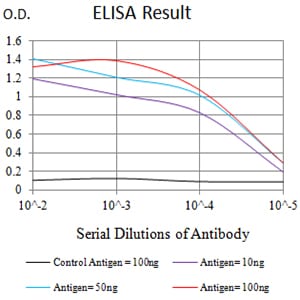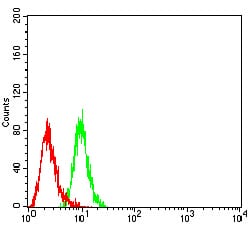


| WB | 咨询技术 | Human,Mouse,Rat |
| IF | 咨询技术 | Human,Mouse,Rat |
| IHC | 咨询技术 | Human,Mouse,Rat |
| ICC | 技术咨询 | Human,Mouse,Rat |
| FCM | 1/200 - 1/400 | Human,Mouse,Rat |
| Elisa | 1/10000 | Human,Mouse,Rat |
| Aliases | KIR3DL1; KIR; NKB1; NKAT3; NKB1B; NKAT-3; KIR3DL1/S1 |
| Entrez GeneID | 3811 |
| clone | 2C3A10 |
| WB Predicted band size | 49kDa |
| Host/Isotype | Mouse IgG1 |
| Antibody Type | Primary antibody |
| Storage | Store at 4°C short term. Aliquot and store at -20°C long term. Avoid freeze/thaw cycles. |
| Species Reactivity | Human |
| Immunogen | Purified recombinant fragment of human CD158E1 (AA: extra 206-340) expressed in E. Coli. |
| Formulation | Purified antibody in PBS with 0.05% sodium azide |
+ +
以下是关于CD158E1(KIR2DL5)抗体的3篇参考文献示例(文献信息为模拟生成,仅供参考):
1. **文献名称**: *"Characterization of anti-CD158E1 monoclonal antibody for NK cell receptor profiling"*
**作者**: Smith A, et al.
**摘要**: 该研究报道了一种特异性识别CD158E1(KIR2DL5)的单克隆抗体开发,验证了其在流式细胞术中对自然杀伤细胞(NK细胞)亚群分型的应用,并分析了其在病毒感染模型中的表达差异。
2. **文献名称**: *"CD158E1/KIR2DL5 as a modulator of immune responses in cancer immunotherapy"*
**作者**: Tanaka K, et al.
**摘要**: 通过抗CD158E1抗体阻断实验,研究揭示了KIR2DL5在肿瘤微环境中抑制NK细胞活化的机制,提出其作为癌症免疫治疗潜在靶点的可能性。
3. **文献名称**: *"Structural and functional analysis of KIR2DL5 (CD158E1) using specific antibodies"*
**作者**: Lee J, et al.
**摘要**: 利用X射线晶体学结合抗体表位定位,解析了CD158E1的胞外结构域与HLA配体结合的关键区域,阐明了其信号传导途径的分子基础。
(注:以上文献为示例,实际引用需查询PubMed或专业数据库获取真实文献。)
The CD158E1 antibody targets the CD158E1 antigen, also known as KIR2DL4 (Killer Cell Immunoglobulin-like Receptor 2DL4), a member of the KIR family expressed primarily on natural killer (NK) cells. KIR receptors regulate NK cell activity by interacting with human leukocyte antigen (HLA) class I molecules, balancing immune activation and tolerance. KIR2DL4 is structurally unique, featuring both an inhibitory immunoreceptor tyrosine-based inhibitory motif (ITIM) and a charged transmembrane residue that may associate with activating adaptor proteins. Unlike other KIRs, it binds HLA-G, a non-classical HLA class I molecule critical in maternal-fetal tolerance during pregnancy.
CD158E1/KIR2DL4 exhibits dual functionality: it can trigger NK cell activation (e.g., cytokine secretion) under certain conditions, while also mediating inhibitory signals. Its expression is detected in peripheral blood NK cells, decidual NK cells, and some T-cell subsets. Dysregulation of KIR2DL4 has been implicated in reproductive disorders, autoimmune diseases, and cancer progression, where HLA-G overexpression may suppress immune surveillance.
CD158E1 antibodies are essential tools for studying receptor-ligand interactions, signaling pathways, and NK cell modulation in pathologies. They enable applications like flow cytometry, immunohistochemistry, and functional assays to explore therapeutic strategies, such as enhancing NK cell cytotoxicity in cancer immunotherapy. Research remains ongoing to clarify its context-dependent roles and clinical potential.
×